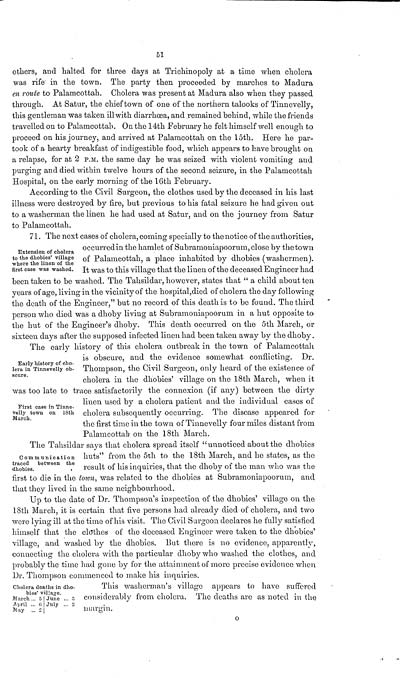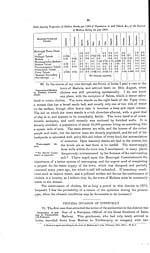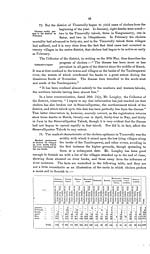Medicine - Disease > Cholera in southern India
(75) Page 51
Download files
Individual page:
Thumbnail gallery: Grid view | List view

51
others, and halted for three days at Trichinopoly at a time when cholera was rife in the town. The party then proceeded by marches to Madura en route to Palamcottah. Cholera was present at Madura also when they passed through. At Satur, the chief town of one of the northern talooks of Tinnevelly, this gentleman was taken ill with diarrha, and remained behind, while the friends travelled on to Palamcottah. On the 14th February he felt himself well enough to proceed on his journey, and arrived at Palamcottah on the 15th. Here he partook of a hearty breakfast of indigestible food, which appears to have brought on a relapse, for at 2 P.M. the same day he was seized with violent vomiting and purging and died within twelve hours of the second seizure, in the Palamcottah Hospital, on the early morning of the 16th February.
According to the Civil Surgeon, the clothes used by the deceased in his last illness were destroyed by fire, but previous to his fatal seizure he had given out to a washerman the linen he had used at Satur, and on the journey from Satur to Palamcottah.
Extension of cholera
to the dhobies' village
where the linen of the
first case was washed.
71. The next cases of cholera, coming specially to the notice of the authorities,
occurred in the hamlet of Subramoniapoorum, close by the town of Palamcottah, a place inhabited by dhobies (washermen). It was to this village that the linen of the deceased Engineer had
been taken to be washed. The Tahsildar, however, states that " a child about ten years of age, living in the vicinity of the hospital, died of cholera the day following the death of the Engineer," but no record of this death is to be found. The third person who died was a dhoby living at Subramoniapoorum in a hut opposite to the hut of the Engineer's dhoby. This death occurred on the 5th March, or sixteen days after the supposed infected linen had been taken away by the dhoby.
Early history of cho-
lera in Tinnevelly ob-
scure.
First case in Tinne-
velly town on 18th
March.
Communication
traced between the
dhobies.
The early history of this cholera outbreak in the town of Palamcottah
is obscure, and the evidence somewhat conflicting. Dr. Thompson, the Civil Surgeon, only heard of the existence of cholera in the dhobies' village on the 18th March, when it
was too late to trace satisfactorily the connexion (if any) between the dirty-
linen used by a cholera patient and the individual cases of cholera subsequently occurring. The disease appeared for the first time in the town of Tinnevelly four miles distant from Palamcottab on the 18th March.
The Tahsildar says that cholera spread itself "unnoticed about the dhobies
huts" from the 5th to the 18th March, and he states, as the result of his inquiries, that the dhoby of the man who was the
first to die in the town, was related to the dhobies at Subramoniapoorum, and that they lived in the same neighbourhood.
Cholera deaths in dho-
bies' village.
March 5
June 3
April 6
July 2
May 2
...
Up to the date of Dr. Thompson's inspection of the dhobies' village on the 18th March, it is certain that five persons had already died of cholera, and two were lying ill at the time of his visit. The Civil Surgeon declares he fully satisfied himself that the clothes of the deceased Engineer were taken to the dhobies' village, and washed by the dhobies. But there is no evidence, apparently, connecting the cholera with the particular dhoby who washed the clothes, and probably the time had gone by for the attainment of more precise evidence when Dr. Thompson commenced to make his inquiries.
This washerman's village appears to have suffered considerably from cholera. The deaths are as noted in the margin.
o
others, and halted for three days at Trichinopoly at a time when cholera was rife in the town. The party then proceeded by marches to Madura en route to Palamcottah. Cholera was present at Madura also when they passed through. At Satur, the chief town of one of the northern talooks of Tinnevelly, this gentleman was taken ill with diarrha, and remained behind, while the friends travelled on to Palamcottah. On the 14th February he felt himself well enough to proceed on his journey, and arrived at Palamcottah on the 15th. Here he partook of a hearty breakfast of indigestible food, which appears to have brought on a relapse, for at 2 P.M. the same day he was seized with violent vomiting and purging and died within twelve hours of the second seizure, in the Palamcottah Hospital, on the early morning of the 16th February.
According to the Civil Surgeon, the clothes used by the deceased in his last illness were destroyed by fire, but previous to his fatal seizure he had given out to a washerman the linen he had used at Satur, and on the journey from Satur to Palamcottah.
Extension of cholera
to the dhobies' village
where the linen of the
first case was washed.
71. The next cases of cholera, coming specially to the notice of the authorities,
occurred in the hamlet of Subramoniapoorum, close by the town of Palamcottah, a place inhabited by dhobies (washermen). It was to this village that the linen of the deceased Engineer had
been taken to be washed. The Tahsildar, however, states that " a child about ten years of age, living in the vicinity of the hospital, died of cholera the day following the death of the Engineer," but no record of this death is to be found. The third person who died was a dhoby living at Subramoniapoorum in a hut opposite to the hut of the Engineer's dhoby. This death occurred on the 5th March, or sixteen days after the supposed infected linen had been taken away by the dhoby.
Early history of cho-
lera in Tinnevelly ob-
scure.
First case in Tinne-
velly town on 18th
March.
Communication
traced between the
dhobies.
The early history of this cholera outbreak in the town of Palamcottah
is obscure, and the evidence somewhat conflicting. Dr. Thompson, the Civil Surgeon, only heard of the existence of cholera in the dhobies' village on the 18th March, when it
was too late to trace satisfactorily the connexion (if any) between the dirty-
linen used by a cholera patient and the individual cases of cholera subsequently occurring. The disease appeared for the first time in the town of Tinnevelly four miles distant from Palamcottab on the 18th March.
The Tahsildar says that cholera spread itself "unnoticed about the dhobies
huts" from the 5th to the 18th March, and he states, as the result of his inquiries, that the dhoby of the man who was the
first to die in the town, was related to the dhobies at Subramoniapoorum, and that they lived in the same neighbourhood.
Cholera deaths in dho-
bies' village.
March 5
June 3
April 6
July 2
May 2
...
Up to the date of Dr. Thompson's inspection of the dhobies' village on the 18th March, it is certain that five persons had already died of cholera, and two were lying ill at the time of his visit. The Civil Surgeon declares he fully satisfied himself that the clothes of the deceased Engineer were taken to the dhobies' village, and washed by the dhobies. But there is no evidence, apparently, connecting the cholera with the particular dhoby who washed the clothes, and probably the time had gone by for the attainment of more precise evidence when Dr. Thompson commenced to make his inquiries.
This washerman's village appears to have suffered considerably from cholera. The deaths are as noted in the margin.
o
Set display mode to: Large image | Zoom image | Transcription
Images and transcriptions on this page, including medium image downloads, may be used under the Creative Commons Attribution 4.0 International Licence unless otherwise stated. ![]()
| India Papers > Medicine - Disease > Cholera in southern India > (75) Page 51 |
|---|
| Permanent URL | https://digital.nls.uk/74534310 |
|---|




